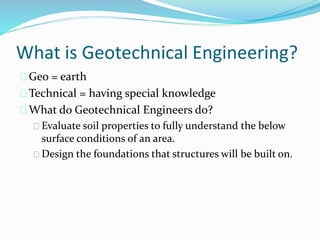The 4-Minute Rule for Geotheta
The 4-Minute Rule for Geotheta
Blog Article
Geotheta - Questions
Table of ContentsA Biased View of GeothetaGeotheta Fundamentals ExplainedThe Ultimate Guide To GeothetaThe 7-Minute Rule for Geotheta
They work together with civil designers, architectural engineers, architects, and various other experts to incorporate geotechnical considerations into the overall project style and construction process. This requires effective teamwork, sychronisation, and interaction to make certain that the geotechnical aspects align with the task goals and satisfy regulatory needs.Mining & Materials Engineering: Concepts of drilling, infiltration prices, and factors impacting the choice of boring method. Qualities of explosives, shooting systems and blast patterns. Blasting methods in surface and underground functions. Unique blowing up techniques at excavation boundaries. Vibration and noise control. Mechanical and continuous approaches to fragmentation, consisting of longwall shearing and fullface boring.
Modelling of fragment and particle dimension distributions; comminution as a transfer function. Comminution innovation: crushing, grinding, dimension category. Integrated analysis of fragmentation and comminution procedures. Provided by: Mining & Materials Design.
Geotheta - Questions
Bachelor's degree programs in civil, geotechnical, geological, and environmental design usually last 4 years and consist of general education and learning courses in English, social science, and the humanities, as well as courses in sophisticated maths, structural geology, and liquid mineralogy. (https://www.cheaperseeker.com/u/geotheta)
Geotechnical design involves the analysis of the soil and rock problems at a specific site, and their effects for the development of that website. As a lot of frameworks rely on the ground for assistance, it is without surprise that an in-depth understanding of the ground conditions, and the viability of foundation systems, are essential to the long-lasting security and efficiency of the building or framework.
Specialising in the investigation of geological developments and ground behaviour, geotechnical designers execute scientific investigations and testing to comprehend the influence these geological developments might carry the layout and building of building, civil and infrastructure jobs. This expertise is essential for the layout and building and construction of buildings, roads, tunnels, dams, bridges, and supply of water and sewer system.
The geotechnical team at Douglas Partners regularly speak with architects, design engineers, developers, and home builders to make suggestions on layout and development propositions to make certain that the developed frameworks are appropriately created for the ground conditions. The layout of footing systems needs to consider the weight of the framework, the capacity of the ground to support that weight with each other with movement tolerances and reliable building.
Getting The Geotheta To Work
This task is considerably streamlined by the use our Douglas Map geospatial system that makes this information readily easily accessible in a very easy to make use of internet internet browser interface. A geotechnical designer will direct the boring of boreholes and test pits to collect soil and other examples, and also assess surface area functions and ground exposures to form a geotechnical version of the subsurface conditions.
Depending on the job kind and ground problems ran into, lab testing may amongst other points examine stamina, compressibility, sensitivity and/or leaks in the structure of dirt and rock examples. Hereafter information is accumulated and collated, the outcomes are made use of for a geotechnical design of the website, which is typically provided as areas throughout the site.

A geotechnical examination naturally can only evaluate the ground conditions at the image source locations drilled or dug deep into. All-natural variants in dirt and rock conditions can happen throughout a site and between examination places. It is for that reason excellent technique that the geotechnical engineer be retained throughout building of the task to provide on-site confirmation that the ground problems run into are regular with the expectations and recommendations provided in the geotechnical examination record.
Getting The Geotheta To Work
Geotechnical designers use their thorough understanding of dirt and rock to analyze threat and address problems on diverse facilities projectsGeotechnical engineering is a specialist branch of civil design which considers the behavior of earth products and the application of dirt and rock technicians. Tailings Engineer. As a geotechnical designer, you will certainly evaluate the physical, mechanical and chemical residential or commercial properties of soil and rock in order to develop structures, keeping frameworks and earthworks
Geotechnical design is closely linked to and overlaps with, both engineering geology and ground design - https://www.merchantcircle.com/blogs/geotheta-miami-fl/2024/8/Why-Geotechnical-Engineers-at-Geotheta-Are-Your-Best-Bet/2781881. It's possible to specialise in geotechnics or work for a geotechnical business however be called an engineering rock hound or a ground designer. As a geotechnical designer, you'll require to: develop and preserve relationships with customers and various other experts associated with the website, throughout each projectmaintain security standards on site bear in mind expense implications when you make recommendationsstudy geological maps and airborne pictures from a variety of resources and from different time periodsexamine building plans to see exactly how practical they are based on your understanding of the siteinvestigate threats or geological risks for the sitesearch for ecologically delicate functions, such as garbage dump begin to establish factual and interpretive ground modelsplan field investigationsdrill and evaluate samples of bedrock, dirt, groundwater and additional products monitor various other experts on sitesolve technological issues as they occur, such as unexpected structures at drill sitesmonitor conditions throughout and after building and construction to make sure structures are steady in the short and lengthy termadding data accumulated on website to your first researchcreating geotechnical computations, illustrations, and 2 or three-dimensional computer system versions interpreting the datamaking recommendations regarding the proposed usage of the website

Report this page